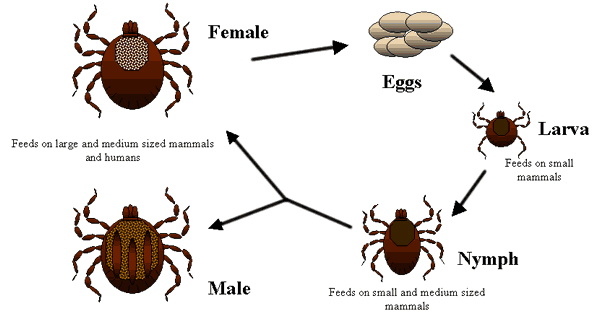Ticks are invertebrate animals in the phylum Arthropoda, and are related to spiders. Ticks are in the subclass Acari which consists of many orders of mites and one tick order, the Ixodida. Some mites are parasitic, but all ticks are parasitic feeders on blood.
Ticks of domestic animals directly cause poor health and loss of production to their hosts by many parasitic mechanisms. Ticks also transmit numerous kinds of viruses, bacteria, and protozoa between domestic animals. These microbes cause diseases which can be severely debilitating or fatal to domestic animals, and may also affect humans. Ticks are especially important to domestic animals in tropical and subtropical countries, where the warm climate enables many species of ticks to flourish. Also, the large populations of wild animals in warm countries provide a reservoir of ticks and infective microbes that spread to domestic animals. Farmers of livestock animals use many methods to control ticks, and related treatments are used to reduce infestation of companion animals.
Lifecycles of Hard Ticks:
Hard ticks have a variety of life histories with respect to optimizing their chance of contact with an appropriate host to ensure survival. Some ticks feed on only one host throughout all three life stages. These ticks are called one host ticks. This type of tick remains on one host during the larval and nymphal stages, until they become adults, and females drop off the host after feeding to lay their batch of eggs. Other ticks feed on two hosts during their lives and are called two host ticks. This type of tick feeds and remains on the first host during the larval and nymphal life stages, and then drops off and attaches to a different host as an adult for its final blood meal. The adult female then drops off after feeding to lay eggs. Finally, many ticks feed on three hosts, one during each life stage, and are appropriately named three host ticks. These ticks drop off and reattach to a new host during each life stage, until finally the adult females lay their batch of eggs. In each case, the fed adult stage is terminal, that is, after laying one batch of eggs the female dies, and after the male has reproduced, he dies as well.

Habitat:
Tick species are widely distributed around the world, but they tend to flourish more in countries with warm, humid climates, because they require a certain amount of moisture in the air to undergo metamorphosis, and because low temperatures inhibit their development from egg to larva.
Control:
Tick elimination is a combination of chemical and non-chemical control methods in and around your home, as well as removing ticks from dogs. Chemical elimination of ticks includes insecticide sprays and insecticide dusts. This article will detail both because both are important if you wish to rid your home and property of ticks.
Keeping grass and weeds cut short in tick infested areas increases tick desiccation during hot weather.
Removal of abandoned birds' nests in and around the property will reduce tick numbers.
Contact your pest management professional and request an inspection, to prepare a comprehensive pest management plan that will effectively and efficiently deal with the specific pest problem.

